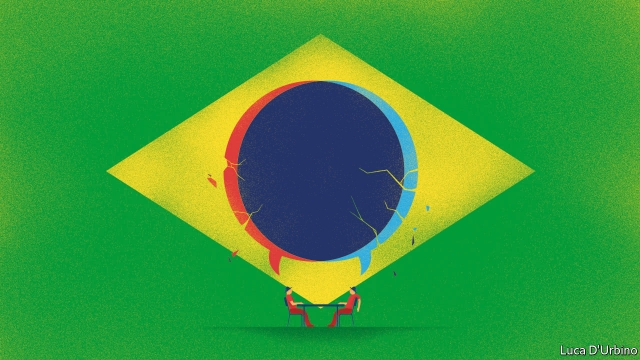Serafina Corrêa calls itself the “capital” of Talian, one of about 30 non-indigenous tongues used in Brazil, especially in the south. They include Polish, Russian and Dutch, but also rare dialects such as Trentino, another import from northern Italy, and Riograndenser Hunsrückisch and East Pomeranian, both forms of German. Their speakers fret that the advance of Portuguese will drive them to extinction. Marli Zanella, who works in a boutique in Serafina Corrêa, complains that when she addresses her 23-year-old daughter in Talian, “she only replies in Portuguese.”
The dialects have survived other threats. Getúlio Vargas, Brazil’s president when it entered the second world war on the allies’ side, banned all foreign languages, the most common of which were German and Italian. “Many people went to jail,” says Paulo Massolini, a doctor who heads the Federation of Italian-Brazilian Associations of Rio Grande do Sul. These days, Talian speakers are pilloried rather than prosecuted. Some have trouble pronouncing nasal diphthongal sounds in Portuguese words such as pão (bread).
Although Talian and the other dialects are hybrids, their defenders fear that the Portuguese influence is becoming dominant. In the 1950s a fatigued Talian speaker would have called himself stanco; today, he is likely to say he is cansado—tired in Portuguese—says Dr Massolini. In Hunsrückisch, schuhloja—shoe shop—is reassuringly a hybrid of the German for shoe with the Portuguese for shop. But an aeroplane is simply an aviong, from the Portuguese avião rather than the German Flugzeug.
Talian has an energetic lobbying campaign behind it, which may improve its chances of survival. Known formerly as “Venetian-Brazilian”, Dr Massolini and other campaigners coined the new name in 1995. It comes from Venetians’ habit of dropping the first and last vowel sounds of some words. Talian champions published a grammar. Dictionaries and teach-yourself books followed. In 2009 Serafina Corrêa’s municipal council ordered that official documents be printed in Talian as well as Portuguese, and in 2014 Brazil’s ministry of culture recognised it as part of the country’s cultural heritage. Mr Massolini is pressing UNESCO to recognise it.
Speakers of less favoured dialects are resentful and envious. Talian speakers in Serafina Corrêa “act as if their variant is the correct one”, complains Giorgia Miazzo, a linguist who has recorded speakers of Italian dialects across Brazil. (They have 15 different ways of saying “yellow”, she found. In Talian, it’s gialdo.) Cléo Altenhofen, a linguist at the Federal University of Rio Grande do Sul, laments that Hunsrückisch, spoken by some 1.2m descendants of immigrants from Rhineland-Palatinate, lacks Talian’s celebrity. “They have dictionaries, and we have a research project,” he says wistfully.
He and his colleagues are mapping the regions in which Hunsrückisch is spoken and have amassed 800 hours of audio recordings. “It’s the first step in getting it formally recognised,” he says. He dreams of opening a museum of linguistic diversity.
But museums and dictionaries are feeble defence against globalisation and urbanisation. The best way of keeping the dialects alive would be to use them as a medium of instruction in public schools. But the national government sets the curriculum, so that is unlikely to happen. Parents are a poor substitute for teachers. “The more you make kids speak a language the more they rebel,” says Mr Altenhofen. His 16-year-old daughter is learning Japanese. She wants to study Korean next.
The Economist
More about: Brazil
















































